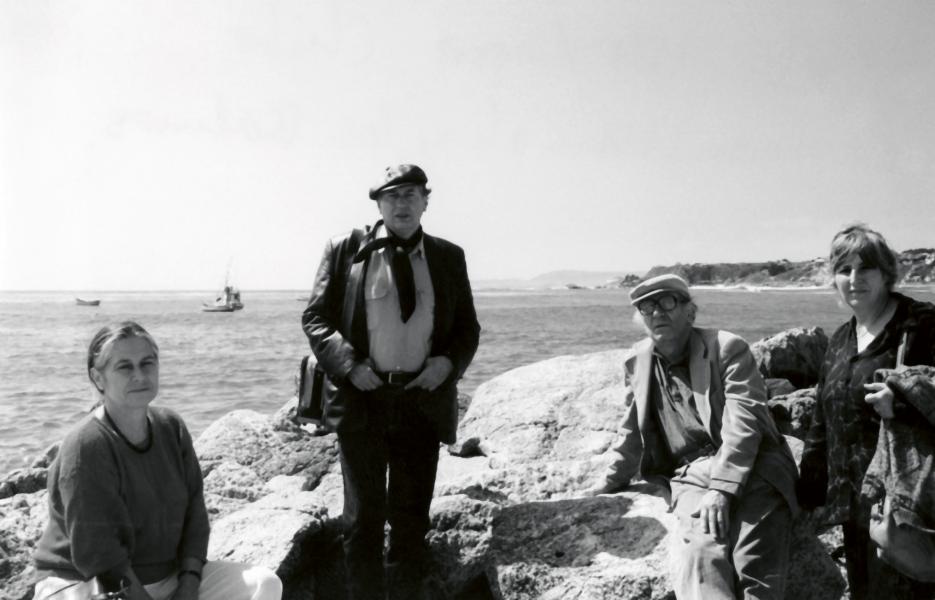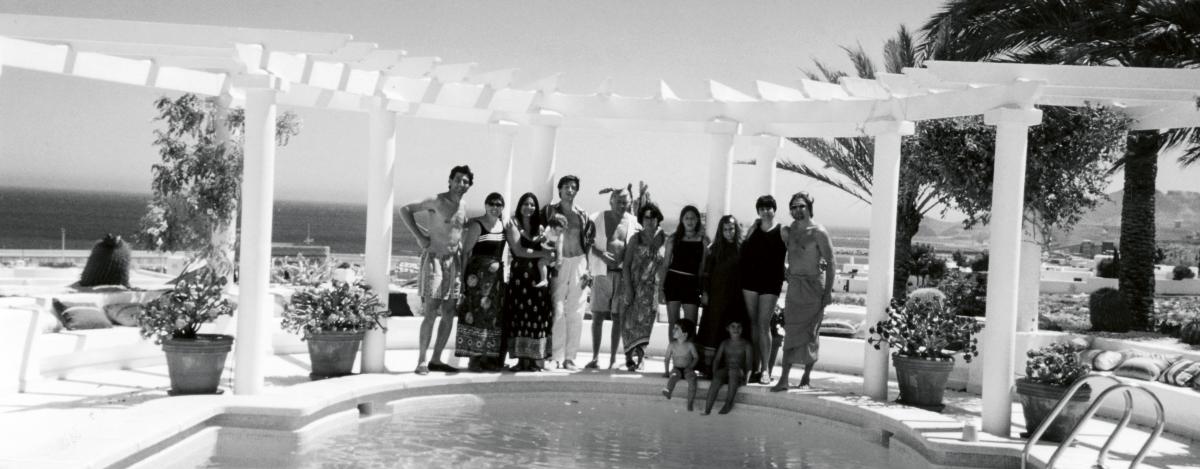1988
Le Parc was invited to the congress of the Unión de Escritores y Artistas de Cuba in Havana, which allowed him to attend many of its sessions. In that climate of changes and proposals, he produced a small, constructively critical salute.
Le Parc, developing the themes of his Modulations, produced a new series under the generic title Alchemies. He devoted several months of 1988 to preparations for a retrospective exhibition covering thirty years of artistic production. The exhibit, Le Parc & Le Parc (incorporating works by members of his family), was held in the National Galleries of the Visual Arts Section of the Secretariat of Culture, Argentina. This gave him a fresh opportunity to reestablish contact with his country of birth and its cultural circles. On this occasion, Le Parc created a fireworks display on Avenida 9 de Julio and in the gardens of Recoleta, with music by Astor Piazzolla, an open-air presentation of clothing by Martha Le Parc, and singing by Yamil.
Gabriel Le Parc made a film based on Julio Le Parc’s audio-visual and book Historietas.
 Buenos Aires, 1988
Buenos Aires, 1988  Avec Alberto Elia et Eduardo Rodriguez, Buenos Aires, 1988
Avec Alberto Elia et Eduardo Rodriguez, Buenos Aires, 1988  Avec Mario Robirosa, Lisandro et Marta Bril. Buenos Aires, 1988
Avec Mario Robirosa, Lisandro et Marta Bril. Buenos Aires, 1988 1989
Le Parc extended his stay in Argentina—six months in all. Traveled to Uruguay, Chile, and Mendoza, Argentina to organize his retrospective.
Visited northern Argentina. Le Parc was made a distinguished citizen of his native city Mendoza, where he presented his retrospective, giving him the opportunity to speak with the city’s people. He later installed his retrospective in Santiago de Chile and dedicated it to Pablo Neruda and the Chilean people; several other public activities and round tables. He was the guest of honor at the second Cuenca Biennial, where he showed two installations titled Luminosas (Luminous).
In Buenos Aires, Gabriel Le Parc produced a film on the career of Julio Le Parc.
 Avec des anciens collègues de l’école primaire, Mendoza, 1989
Avec des anciens collègues de l’école primaire, Mendoza, 1989  Avec José Balmes, Santiago de Chile, 1989
Avec José Balmes, Santiago de Chile, 1989  Avec Hernan et Gladys de Zapata, Quito, 1989
Avec Hernan et Gladys de Zapata, Quito, 1989  Avec Carmen Waugh et les Balmes, Isla Negra, Chili, 1989
Avec Carmen Waugh et les Balmes, Isla Negra, Chili, 1989 1990
Le Parc continued his development of the theme Alchemies, mounting the first presentation of these works in the Rayuela gallery in Madrid. He traveled to several cities in Europe (Genoa, Palazzolo sull'Oglio, Milan, Venice, Bilbao) for solo shows. Le Parc began work on a public art project for the Garden of Memory in Zaragoza, in the state of Aragón in Spain.
1991
Le Parc’s work with the Espace Latin-Americain in Paris continued. All its members tried to restore it and ensure its survival.
Le Parc worked on projects for expanding his studio-home in Carbonera, Almería, in Andalucía, Spain.
1992
Another trip to Buenos Aires for a solo exhibit, at the Van Eyck Gallery, of some of his Alchemies.
Visited the Fondation Maeght in St.-Paul de Vence on the occasion of his exhibit L’Art en Mouvement.
During the World’s Fair in Seville, Le Parc installed a gallery of his works with light within the exhibition Artistas Latino-Americanos del siglo XX. This exhibit later traveled to the Centre Pompidou in Paris, under the title Art d’Amerique Latine 1911–1968.
 Avec Victor Chab et Manuilo, Buenos Aires, 1992
Avec Victor Chab et Manuilo, Buenos Aires, 1992 1993
The Espace Latino-Americaine in Paris closed. The space had been inaugurated in 1980 with an exhibition of all the Latin American artists then in Paris.
Le Parc traveled to New York to present his light gallery within the exhibit Latin American Artists of the Twentieth Century at the MoMA.
Le Parc prepared a series of projects combining light and movement for the Schadow-Arkaden, a shopping mall in Düsseldorf.
Le Parc chaired a roundtable of critics, artists, and philosophers at the Collège International de Philosophie de Paris.
 Avec la famille de sa sœur et Juancito, New York, 1993
Avec la famille de sa sœur et Juancito, New York, 1993  Avec Horacio Ferrer, Paris, 1993
Avec Horacio Ferrer, Paris, 1993  Avec Federico Brook et Darnet, Rome, 1993
Avec Federico Brook et Darnet, Rome, 1993  Naissance de Mateo, son petit-fils, Ivry, 1993
Naissance de Mateo, son petit-fils, Ivry, 1993 1994
Le Parc spent a great deal of time searching for ways to improve, renovate, and expand his studio in Cachan, even producing a scale model. He pursued the idea of creating a catalogue raisonée of his work. He searched for texts, documents, photos that might comprise a first mock-up.
Production of one of his projects for the Dusseldorf Schadow-Arkaden.
 Exposition Big &Great, Brescia, 1994
Exposition Big &Great, Brescia, 1994  Avec Renata et Franco Rossi, Paris, 1994
Avec Renata et Franco Rossi, Paris, 1994  Avec Luna et Mateo, Cachan, 1994
Avec Luna et Mateo, Cachan, 1994  Avec Martha et Fromanger, en Toscane, 1994
Avec Martha et Fromanger, en Toscane, 1994 1995
Le Parc restored a series of his works with light, particularly those from the sixties, for inclusion in a thematic retrospective titled Les Années Lumières at the Bremen gallery, in central France.
What occupied most of Le Parc’s time in early 1995 was a project in collaboration with Jean-Louis Pradel for a book on his work and career. Le Parc looked back over his long years of work. For the first time, his future plans took an essential back seat to introspection. As he went through old photographs and documents and reread texts, entire parts of his life came back to him. He felt nostalgic, but that allowed him to discover a new perspective on himself and to rethink what his life and work had meant.
His fondest hope was that the book, which would summarize his life and his constant, dogged work, would make evident the profound meaning of his explorations.
After great effort, the book Julio Le Parc by Jean-Louis Pradel was published, in French, in Milan by Severgnini. The most comprehensive book on Le Parc’s work to that date.
Hugo de Marco, a friend from the Escuela de Bellas Artes in Buenos Aires, died. De Marco was a co-founder of GRAV, and although he had withdrawn rather quickly, he and Le Parc remained personal and professional friends to the end, and Le Parc considered him a fine artist.
 Avec la famille, Carboneras, 1995
Avec la famille, Carboneras, 1995  Avec Michel Le Brun, Jean-Louis Pradel et Roxanna, La Brenne, 1995
Avec Michel Le Brun, Jean-Louis Pradel et Roxanna, La Brenne, 1995 1996
Le Parc became a member of the Committee of Artists in Paris against Apartheid in South Africa.
The exhibit Les Années Lumières opened in Paris in the Espace Electra. This exhibit took place parallel to two other exhibitions, one in the Galerie Dionne in Paris and the other in Anis Gras in Arcueil, which opened with a wonderful Latin American celebration with, among others, Yamil Le Parc with a repertoire of tangos.
Yvaral, tired of people saying he copied Soto every time he exhibited his works from the seventies, called on several friends from GRAV. The result: Yvaral produced an illustrated brochure comparing subjects and dates of his works against those of Soto. In solidarity with Yvaral, Le Parc wrote a text that went beyond the conflict between the two artists.
 Avec le directeur de l’Espace Electra. Paris, 1996
Avec le directeur de l’Espace Electra. Paris, 1996  Avec Anne Husson, Paris, 1996
Avec Anne Husson, Paris, 1996  Avec Zazie et Mme Cohen, Paris, 1996
Avec Zazie et Mme Cohen, Paris, 1996  Avec Frank Popper, Paris, 1996
Avec Frank Popper, Paris, 1996  Avec Michel Le Brun, Paris, 1996
Avec Michel Le Brun, Paris, 1996  Avec Alejandro Marcos, Paris, 1996
Avec Alejandro Marcos, Paris, 1996